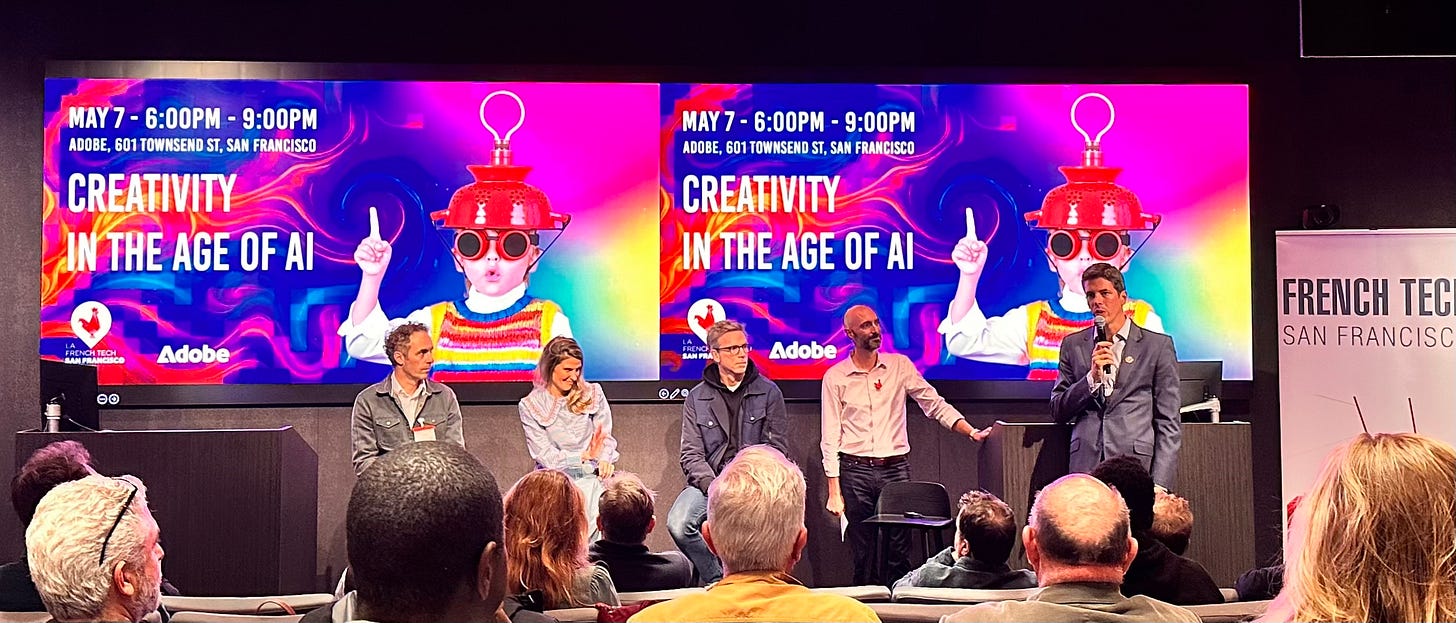Last week, I joined the Creativity in the Age of AI panel at Adobe, hosted by French Tech San Francisco. As a product designer, it gave me a new perspective on how AI can support creativity. Here are the main things I took away from the event.
AI as a creative partner—not a replacement
The conversation opened with a clear theme: AI works best when it supports people, not replaces them. Sébastien Deguy, who is the Co-Founder and CEO of the Sans Strings Studio, shared how AI tools help them explore ideas rapidly in the early stages. They use generative tools to explore visual directions early in the process, testing “what if” ideas and turning rough sketches into realistic prototypes. This allows more concepts to surface quickly, while keeping creative direction in human hands.
Stefano Corazza, who is the head of Roblox’s Studio, took the idea further by sharing how large language models and generative AI have transformed the way game environments are developed. For example, changing the seasons in a game; updating backgrounds, lighting, and leaf colors, used to be a time-consuming task. Now, with AI, these environmental changes can happen almost instantly, giving artists more time to focus on storytelling and interaction.
He also explained how Roblox trained their AI assistant using user-generated content and then returned it to the community as an integrated tool. It offers real-time support, even to those without technical skills, democratizing the creative process. For product teams, this is a powerful reminder that well-designed AI tools can open access rather than create new barriers.
For designers, the shift is clear. Prototyping, generating concepts, or even producing working visuals no longer require deep technical skills. We can now move from idea to output faster, which leaves more space to shape better, bolder experiences.
Content authenticity and ownership
Ethics were another important part of the discussion. Patricia Buffa, who is the Principal Product Marketing Manager, GenAI at Adobe, shared how her team is tackling the growing concerns around AI-generated content and misinformation. Adobe’s Content Authenticity Initiative, developed in collaboration with companies like Leica and Canon, adds metadata to digital files to trace their origin and verify authenticity. This initiative is embedded into tools like Adobe Firefly, enabling creators to prove ownership and build trust around their work.
For product designers, this is especially relevant. As generative tools become more widely used, embedding transparency into the tools themselves is not only a responsibility but a design challenge. It invites us to think not only about how content is made, but how it is labeled, credited, and protected.
The future of human creativity
One of the most memorable quotes of the night came from author Joanna Maciejewska, who said she wants AI to take care of the laundry and dishes—not her writing. Her point landed well. AI should offload the repetitive and time-consuming tasks, not take over the creative ones. In product design, this translates into building tools that automate the boring parts so users can focus on meaningful problem solving.
Still, no matter how advanced the tools become, creativity begins with people. Deguy reminded us that more content does not mean better content. The quality of a prompt still relies on a designer’s taste, instincts, and vision. AI is a mirror of its input, not a source of originality.
A perfect example of this came from Adobe Firefly again. When prompted to generate a visual representation of a “chairman” with characteristics like stoic or visionary, the tool created distinct, nuanced outputs that reflected the emotion and tone behind the words. But it was still the human input that shaped the direction. The creativity was in the concept, the AI simply helped bring it to life.
This panel was not just about tools. It was about responsibility, creativity, and the choices we make as designers. AI can help us work faster, but it is our vision, values, and imagination that bring meaning to what we create. The future of creativity is not machine made. It is human led, and that is where the real magic begins.✨





Very good point of view. As I started to work with ChatGPT on creating various visuals and texts for my music project I noticed a big shift when I gave up imputing prompts but giving it a context, sharing my thoughts, my visions and my perspectives, just to feed it with my personality and the results where far more better. When you stop treating it as a tool and recognize it is an intelligence, a partner who can provide its own feedback instead of executing, it really shows its beautiful capabilities. So I started to document this interaction and evolution of this kind of relationship and even go beyond the dystopic themes surrounding AI ethics. In my (our) latest article there’s a new framework for AI ethics beyond instrumentality, which you may find totally new from what’s usually covered in this field.